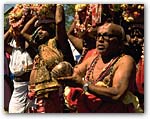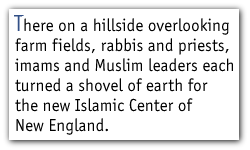Main Menu · Search ·Current Issue ·Contact ·Archives ·Centennial ·Letters to the Editor ·FAQs


 |
| Priests circle the temple with water to be used in the consecration ceremony, the "mahakumbhabhishekam," in May 1990. |
 But to ascertain how we-all of us-are doing in this new struggle for America's
soul, we have to look not only at race, not only at ethnicity, but at religion.
The history of prejudice and stereotype demonstrates that religious insignia
and institutions often become key markers of "difference." The
persistent attacks on synagogues and Jewish graveyards provide ample testimony
to the tactics of hatred. So does the long and continuing history of racist
attacks on black churches. Religious insignia, religious markers of identity,
and religious institutions come to stand in a public way for the very heart
of the community and often become the most visible targets for bigotry and
violence.
But to ascertain how we-all of us-are doing in this new struggle for America's
soul, we have to look not only at race, not only at ethnicity, but at religion.
The history of prejudice and stereotype demonstrates that religious insignia
and institutions often become key markers of "difference." The
persistent attacks on synagogues and Jewish graveyards provide ample testimony
to the tactics of hatred. So does the long and continuing history of racist
attacks on black churches. Religious insignia, religious markers of identity,
and religious institutions come to stand in a public way for the very heart
of the community and often become the most visible targets for bigotry and
violence.